Wilderness Pages
These documents represent a much larger collection of historical documents relating to the Selway-Bitterroot Wilderness that are housed in the library at the University of Idaho. For more information on accessing this collection, please contact Dennis Baird.
Gifford Pinchot Selway Diary
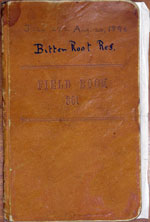 |
Gifford Pinchot’s 1896 Selway River Diary Among those appointed to [the Forest Commission], which served without pay, was a single trained forester, Gifford Pinchot. A related body, the Special Committee, on which Pinchot had also served, had previously recommended a series of on the ground studies of potential forest reserves, and that areas in Montana, Idaho and Oregon “be regarded as of special importance.” (from the introduction by Dennis Baird) |
First Mention of "Wilderness"
 |
Grazing Document, March 9, 1925 Although merely a routine grazing report, this document is significant because it represents the earliest mention of the word "wilderness" to refer to the Selway-Bitterroot area in any correspondence discovered to date. |
Selway Patrol
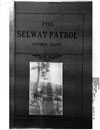 |
Selway Patrol, Kooskia, Idaho, 1 February 1912 “The Selway Patrol,” is an exceptional document. Produced in 1912, it records in detail the conditions of various territories within the Selway National Forest. What is most striking about this document, though, is not the range of its information but the quality of its prose. When compared with more modern documents written by the Forest Service, “The Selway Patrol” is both poetic and philosophical, making at times grand statements about nature and its conservation. Please see especially the introduction and, also, the poem on the final page, “A Tribute to the Forest Ranger” by A. Strohecker of the U. S. Geological Survey. |
Shearer
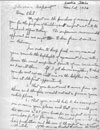 |
Letter, George W. Case to Phil Shearer, 1 December 1933 In this rare, hand-written letter, Ranger George W. Case informs private landowner Phil Shearer that the Forest Service has received approval to purchase a portion of his land for the purposes of building an airstrip. This letter marks the beginning of a long controversy between Forest Service personnel, local businesses, tourists, and legislative officials over the appropriateness of backcountry airstrips, and the suitability of Shearer airstrip in particular. |
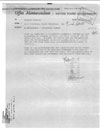 |
In this Memorandum from Assistant Regional Forester F. E. Thieme considers the development of different airstrips within the Bitterroot National Forest, including Shearer. The brief memorandum illustrates the major problems and financial costs of building airstrips in wilderness areas. Thieme’s plans are notable for taking into account post-war funding for federal projects. |
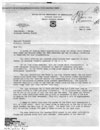 |
Correspondence regarding development of Shearer airstrip, May–June 1933 This series of memoranda demonstrates the contentious nature of the Shearer airstrip, even in 1933 when it was initially considered by Forest Service administrators as a possible landing site. Most arguments centered on safety concerns regarding the fitness of the land: the runway would be short, the landing field would need to be drained, and a Forest Service employee would have to be stationed at the airstrip to maintain good landing conditions. These issues and others would plague the Shearer airstrip for the next sixty years. |
 |
Memorandum, C. D. Blake to the Regional Forester, 18 June 1952 In this brief Memorandum C. D. Blake informs the Regional Forester that “Shearer landing field has been rated as too dangerous for landing small ships.” Blake does not suggest that Shearer be abandoned, as some later opponents of the airstrip will, but he does propose that improvements should be made. |
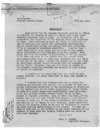 |
Memorandum, from Evan W. Kelley, Regional Forester, 24 July 1936 The memorandum issued by Regional Forester Evan W. Kelley laments the condition of Shearer airstrip, which has been deemed unfit for use by pilot Robert Johnson. In stern remonstration, Kelley makes it clear that the safety of the field must be maintained even with no additional funding allotted for the task: “To risk the loss of life due to our failure to use every resource at our command to make safe our landing fields does not leave us with much defense.” |
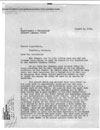 |
In this memorandum, Clarence C. Strong, Assistant Regional Forester, describes the poor condition of the Shearer airstrip and lists a few ways the safety of the strip might be improved. Strong sees potential in Shearer but only if the improvements are made. |
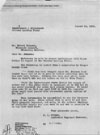 |
In this memorandum, F. E. Thieme, Assistant Regional Forester, relates information to pilot Robert Johnson about the conditions of Shearer airstrip as described by Ranger George W. Case. Johnson had earlier reported that the airstrip at Shearer had been improperly maintained and was dangerous. However, according to Case, “The field has been dragged . . . and is in as good or better condition than it has ever been before.” Disputes about the conditions of Shearer were common and often heated. |
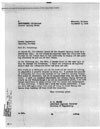 |
Memoranda regarding the safety of Shearer airstrip, 15 September 1944 These two memoranda show the continued struggle to keep Shearer operational. Once again, Robert Johnson expresses serious concerns about the condition of the airstrip. The ranger managing Shearer, Arden B. Gundersen, responds by defending his efforts to keep Shearer safe, but agrees that the field is flooded and impossible to drain. |
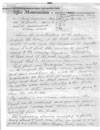 |
J. A. Parsell writes to inform the Regional Forester of a new safety issue at Shearer airstrip. Trees growing at the north end of the mouth of Elk Creek have grown 6 to 8 feet since Shearer was first established, making takeoffs difficult, even dangerous for some aircraft. Parsell suggests that a clearing be made but is quick to claim that the job is too big to be covered by district money and labor. |
 |
Sketch, by Don Halloran, 16 July 1978 This sketch by Don Halloran, drawn in 1978 represents the Shearer Guard Station as it appeared in 1955. |
Salmon River Breaks Reclass
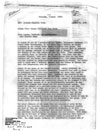 |
Salmon River Breaks Primitive Area Study, 21 August 1970 he Salmon River Breaks Primitive Area Study is indicative of the kind of problems that have faced Forest Service administrators when trying to classify an area as wilderness. Here, a disagreement over boundaries and use value raises the question “just what is contiguous undeveloped land” and how should its use be limited? |
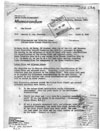 |
Letter, Richard R. Smith to Ray Hunter, 28 May 1970 This letter from Richard R. Smith, a local citizen of Salmon, ID, to Ray Hunter, the Multiple Use Coordinator for the Bitterroot National Forest, demonstrates the dynamic interaction between citizens and the Forest Service. Informed citizens like Smith often played an active role in shaping Forest Service policy. |
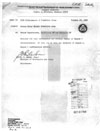 |
Correspondence regarding Salmon River Breaks Primitive Area, July -- September, 1968 This series of letters clearly illustrates the complex issues involved in classifying wilderness areas. See especially the letter from J. M. Herbert, Assistant Regional Forester, to Floyd Iverson, Regional Forester, 15 August 1968, in which Herbert comprehensively evaluates the different classification options. |
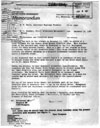 |
This Memorandum from E. C. Slusher, Chief of the Wilderness management Branch, to E. F. Barry, Assistant Regional Forester, is the first official correspondence to discuss how the Salmon River Breaks Primitive Area should be classified. Slusher calls for an extensive study of the area, but already two opposite camps have formed, represented by the Nezperce and the Bitterroot administrators. The former want to keep the area primitive with no permanent resorts while the latter want to include provisions for resorts in the final language of the official classification. This difference in opinion in the Forest Service has defined, and continues to influence, the way wilderness areas are understood. |
Wildlife
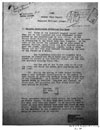 |
1922 Game Report, Nezperce National Forest he 1922 Game Report for the Nezperce National Forest is an important early document because it illustrates the initial development of forest service wildlife management policy. In 1922, the Forest Service was mainly concerned with preserving game animals and saw larger predators, especially coyotes and big cats, as the greatest threat to successful wildlife management, recommending that hunters or trappers be employed to kill predators. But the report also predicts the possible extinction of big game by recreational and commercial hunting and recommends the establishment of a game preserve. |
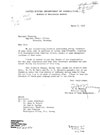 |
Memorandum to Regional Forest Office, Intermountain Region, Missoula, MT This memorandum written in 1937 demonstrates some of the early problems faced by the forest service in managing large populations of wildlife over a vast territory. As previous reports have done, this document proposes employing hunters and trappers to kill large predators, like coyote and cougar, but it also draws attention to a more complex problem, the overuse of winter grazing areas by elk, which have begun to drive out and endanger other large game. In a fascinating moment, the author begins to compare the elk population to human populations in large city centers, drawing an analogy between the two in order illustrate the dangers of natural resource depletion. |
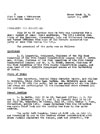 |
Fish & Game, Bitterroot, Cooperative Show-Me Trip Written in 1937, this memorandum is a day-by-day account of a “Show Me Trip” conducted in the Nezperce, Clearwater, Lolo, and Bitterroot Forests. The purpose of the trip was to assess the condition of the wildlife in these forests, but as in most early forest service documents, the issue of access and whether or not to improve it is the most pressing. Here, the author of the document relates a conversation about a primitive road developed by an early railroad survey party, and the party asks themselves the question, better to “wipe the trail off the map and call this a real wilderness where only the hardiest lovers of the mountains could hope to enjoy a trip, or to reconstruct the trail to a good standard so that people who were only moderately adventurous might ride a horse without fear and enjoy the rugged scenery which nature has provided for those with eyes to see.” This same issue continues to be central to both wildlife and forest management. |
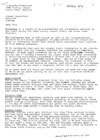 |
W-Reports, Bitterroot, 1946 Hunting Season, Moose Creek District What had been speculation in 1922 was becoming a reality in 1946: pressure from commercial and recreational hunting was beginning to negatively affect the migratory patterns of big game populations, which were now concentrating in and destroying the winter range. The report suggests a more comprehensive model is necessary for the future successful “management of the hunt,” one that takes into account new pressures created by improved access to wilderness areas. |
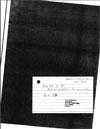 |
Five-Year Fish and Game Report, Region One, 1934 The Five-Year Fish and Game Report for Region One written in 1934 begins by lamenting the inability of the forest service to collect reliable data necessary for the effective management of the “game problem.” The report represents an important call for change in the way the forest service understands and implements game management policy, including the suggestion that they adopt the “principle of control rather than complete extermination of predatory animals.” But this report goes beyond simple game policy, taking into account increases in illegal killing of game due to a rise in unemployment, economic pressures that unexpectedly brought social and wildlife issues into close contact. |
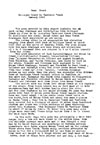 |
Game Count: Bolinger Creek to Gardiner Creek, January 1949 Though in general the Game Count of 1949 gives a detailed report of game conditions in the area between Bolinger Creek to Gardiner Creek, it also relates important historical information concerning wildlife populations. For instance, “Old timers report that soon after the market for elk teeth were gone the elk population began to increase.” This small piece of history demonstrates the interconnection of economic pressures and wildlife health and the need for laws protecting animals that have commodity value in the market. |
 |
Report to the State Game Warden, 11 May 1925 The 1925 Report to the State Game Warden is a comprehensive description and analysis of game conditions on the upper Selway. The report examines a range of issues negatively affecting game, including the lack of salt licks, the occurrence of pests, the threat of predators, and the existence of trapping operations, and makes recommendations for future game management policy. The report ends by admitting, “The recreational value will continue to over balance all else, if nature be not interfered with.” |
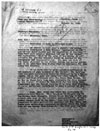 |
Letter, Jefferson to District Forester, 11 January 1923 |
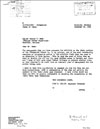 |
Letter, Kelley to Case, 18 December 1942 A rare correspondence between two influential forest service personnel, Evan W. Kelley and George Case. In the letter, Kelley applauds Case’s wildlife management plan for the Idaho portion of the Bitterroot Forest, a plan that Kelley suggests should be adopted in Montana as well. |
 |
Kelley to Chief Forester, 13 February 1939 This letter from Regional Forester Even W. Kelley to the Chief Forester illustrates the importance of agency cooperation in the successful implementation of any wildlife policy. The letter is a summary of the cooperative efforts developed between different state organizations as well as the tensions between federal and state agencies as the forest service tries to develop a plan to deal with game problems that transgress state lines. |
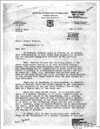 |
Letter, Kelley to Chief Forester, 1 May 1937 In this heated letter, Regional Forester Evan W. Kelley argues that federal agencies should have jurisdiction over lands designated as national forests, and that federal policy should always supersede state policy. The latter, he claims, is inconsistent and obstructs federal efforts to establish an effective wildlife management plan. |
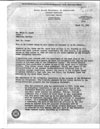 |
Letter, Tebbe to Lloyd 27 March 1961 In March of 1961 Regional Forester Tebbe writes to activist citizen Merle D. Lloyd, reassuring him that the forest service understands the importance of irrigation to the Montana economy. Tebbe opposes Lloyd’s desire to establish a large reservoir because it would “eliminate the entire east face of the Bitterroot Mountains.” Here, Tebbe counters Lloyds economic argument with an aesthetic one: “The east face is the most beautiful and spectacular part of the wilderness area. We feel that it is possible to have both dams and a wilderness area in this situation.” |
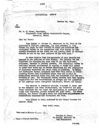 |
Letter, Young to Haven 24 October 1934 In this letter, Stanley P. Young, in charge of the Division of Game Management, defends forest service policy to J. N. Haven, President of the Clearwater River Valley Conservation League, who claims forest service activity has benefited sheep and cattle farmers over sportsmen and hunters. Young counters Haven’s accusation by arguing that the first priority of the forest service is to restore the natural environment as rapidly as possible, which favors the interests of all groups concerned. |
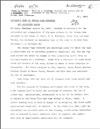 |
Press Release, Emergency Hunt in the Selway Game Preserve, 26 August 1937 This press release issued in August of 1937 is meant to attract hunters to the Selway Game Preserve for a special emergency hunt to last from the beginning of September to the end of November of that year. The release attempts to entice hunters by describing the game preserve as “extremely primitive” providing the hunter with an unprecedented opportunity for “real pioneering sport.” The hunt was organized in response to the explosion of elk that had begun to damage winter grazing areas. |
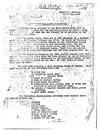 |
Range Management Report, March 1933 This report includes a day-by-day narrative of a 123-mile trip through the Bitterroots made in the winter of 1933 by a group of Forest Service employees. The trip was organized “primarily for law enforcement,” but the resulting narrative includes important observations about area wildlife. |
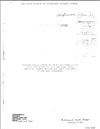 |
This article is unique for the way it addresses how local economies in Idaho are affected by Forest Service policy. Notice on page 2, in a moment of uncommon candor, a sense of frustration emerges as the author describes the population of the Clearwater Valley as “extremely self-centered, provincial in thought, and jealous of their rights.” Both the Forest Service and local citizens feel a sense of ownership, but poised in opposition directions. Whereas the Forest Service is interested in improving access to wilderness, local inhabitants of the Clearwater Valley “feel the wildlife in this area is theirs because of location, and resent the fact that roads though the Bitterroot make it more accessible . . .” The question of whether to expand or limit wilderness access, and who controls that decision, is central to almost every wilderness debate. |
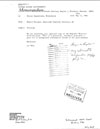 |
Magruder Ranger District, Wildlife Management Plan, 13 May 1964 The Magruder Ranger District Wildlife Management Plan, delivered in May of 1964, argues that accessibility is the most important factor in managing wildlife. If hunters have access, it’s easier to keep big game numbers at a sustainable level and the report makes a number of suggestions for improving access to the Magruder District. Of particular interest is the report’s thorough history of the elk population beginning in 1910, which is characterized as “game population buildup after fire.” From this history, the effects of Forest Service game management policy become readily apparent, especially the record populations maintained between 1938 and 1942.
|
Additional Documents
 |
01. Reconaissance Report, Kit Carson Landing Strip Includes details of a proposed Kit Carson Landing Strip in the area. The document is from 1945 and includes a drawing of the proposed strip as well as two high-altitude photographs of the proposed strip site. The report is authored by F.E. Thieme. |
 |
02. The Early Years of the Bitterroot Forest Reserve: Major Frank Fenn Reports to Washington This is a compilation of a number of documents, and contains an introduction written by Dennis Baird. Some of this introduction appears to be missing, but what is present provides some historical context to the main text, which is a 1901 report from Ranger Frank Fenn written in response to an argument by a Judge Heyburn that the then-called Bitterroot Reserve needed to be shrunk in size. Fenn argues against this idea. At the end of the document are two maps: one shows the Bitterroot Reserve as it was originally established, and the other shows its boundaries in 1907. |
 |
03. Bitter Root (Idaho) Reserve: Personnel This report, penned by “Riley” in 1907, begins by criticizing the administration of the Bitterroot Reserve. This critique leads into a listing of the current personnel, and in-depth descriptions of each. Not only are work habits and abilities (or thereof) discussed, personal appearance, marital status, and other seeming trivialities appear to play an important part in “Riley”'s recommendations for promotions, demotions, and the like. |
 |
04. Letter from E.A. Sherman to Gifford Pinchot. This letter is Sherman's response to a letter from Pinchot requesting (it seems) historical details of the “early days” of the Forest Service's work in the area (the letter itself is dated 1912, hence the quotes around “early days”). Sherman responds with a long personal narrative of his early work with the Service, as well as his own childhood history and how he sees that having effected his eventual career path. |
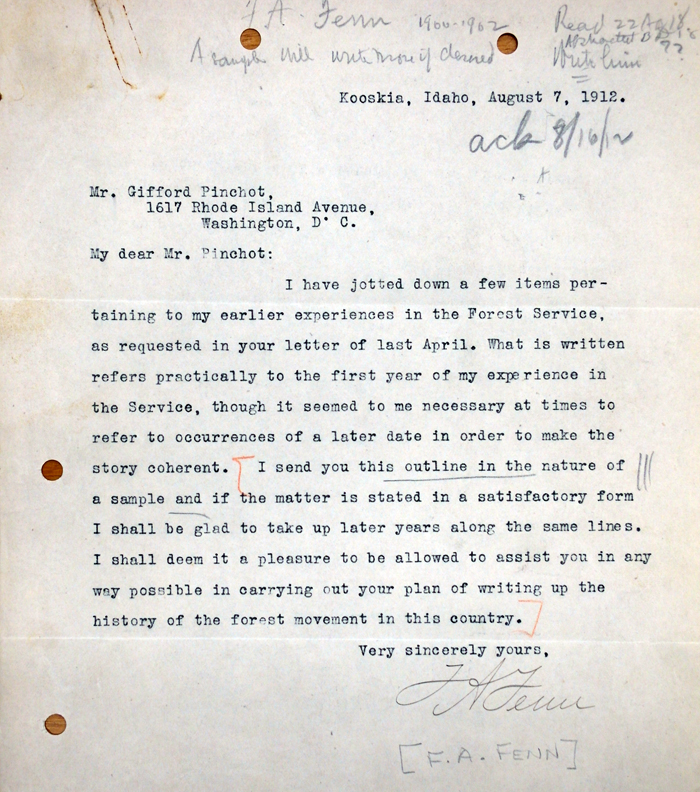 |
05. Letter from Frank Fenn to Gifford Pinchot, August 7, 1912 Kooskia, Idaho. In this letter, Frank Fenn seems to be replying to the same query that Pinchot directed at Sherman; that is, Fenn writes to Pinchot filling him in on the details of his first year as a Forest Ranger. His recitation also encompasses some of the more general history of Forest Service activities in the area. Fenn draws a distinction in practice between today's – 1912's – practices and how things were “in the good old days”. |
 |
06. Proposed improvement to the Moose Creek Bridge, c.1920. This collection of documents deal with a proposed improvement to the Moose Creek Bridge, and run the gamut from parts requisitions, hand-drawn building plans, and a disagreement over whether the bridge should be built in a “quick-and-dirty” fashion or if a more expensive, more wear-resistant bridge should be built. |
 |
07. Proposed improvement to the Pettibone Bridge c1920. This document is similar in content to the previous document, though it deals instead with a proposed bridge spanning Pettibone Creek. There is a short justification statement and an included hand-drawn building plan. |
 |
08. Timeline/history of the Bear Creek Ranger Station from 1912 to 1934. Exactly as titled, this document describes significant occurrences in the history of the Bear Creek Ranger Station from 1912 and 1934. It concludes with a list of personnel who served there over that time span. The timeline is in an outline format. |
 |
09. A history of the Three Forks Ranger Station. This is another timeline of events, this time telling the history of the Three Forks Ranger Station from 1910 to 1920. Unlike Document 8, however, this history is in the form of an essay. No author is indicated. |
 |
10. Memorandum for District Forester: Selway Fire – 1919 This document, authored by Chas F. Howell, discusses how the Selway's fire suppression plan should adapt in the coming years, based on the outcome of the last four fire seasons, from 1916 to 1919. Howell discusses each specific fire season – and sometimes specific fires – at length, using the Service's mistakes as evidence for the changes he suggests. This report is especially interesting when you consider that 1910, 1914, and 1919 were three of the area's worst fire seasons ever, and as such fire suppression policy in the area during the 1910s in general was in a wildly fluctuating state from year to year. This document gives an interesting glimpse into that process of rapid change and response. |
 |
11. “Report” by Elers Koch on the causes of the 1919 Selway fire(s). A report by Elers Koch (the ranger immortalized in Forty Years A Forester) on the massively destructive fire season of 1919. Koch suggests what he sees to be necessary changes to the region's fire-suppression policy, using firsthand experience fighting the fires of 1919 as his evidence. |
 |
This timeline, which runs from 1878 to 1949, was composed by Mary H. Williams. It lists, in outline format, many significant events that took place on and near the Selway River. |
 |
13. Trapping Wildlife Accounts/Chronology This timeline is also authored by Mary H. Williams. It runs from 1812 to 1947, and lists in outline format a great many important moments in the history of trapping in the SBW. Please note: both accounts (numbers 12 & 13) displayed here are essentially one-time snapshots of projects which are works in progress and are continually being improved and corrected. |
 |
14. Historical Happenings in the Macgruder ‘Corridor’ This document is a short, essay-style retelling of the history of the area that would eventually come to be called the Macgruder Corridor. The document was written by Frank Schumaker, an early District Ranger at Magruder and also the author of one of the most important early histories of the west side of the Bitterroot National Forest. The essay starts with the coming of Lewis and Clark to the area and ends around 1920. |
 |
16. Rugged Selway country had its share of tragedy This is a newspaper article documenting the death of the man named Archer, who died in a skiing accident outside of Martin Moe’s cabin in 1899, during a heavy snowstorm. This incident is referenced in a number of Dick Walker's interviews. This document includes a hand-drawn map and diagram of what is supposed to have happened in the Archer accident. |
 |
17. Earlyday Foresters Were Hardy and Practical, Bessie Notes in Recolections of Forest Service This is a newspaper article of recollections of the early days of the Forest Service in the SBW, as told by Roy Munroe’s wife, Bessie. She profiles a number of old rangers, including Jim Vance, her own husband, and Frank Fenn, among others. |
 |
18. “Major Evan W. Kelley”, a biography/obituary of the man. Pretty self-explanatory. Tells of Kelley's childhood, his service in WWI, and then, ultimately, his work with the Forest Service. |
 |
An excellent outline by Dick Walker of various Selway-area homesteads and those who originally lived in those cabins. Content deals with such men as Phil Shearer, Henry Pettibone, Alvin Renshaw, Tom Running, Martin Moe and the Wolfinbargers (Ole and Punk and Carolyn). |
 |
20. History of the Running Creek Homestead, 1898 to 1920 This is a long essay by Dick Walker. It begins with an introduction explaining the general state of the SBW area before its “discovery” by Lewis and Clark. This introduction also describes the resulting white settlement and the early trapping in the area. The rest of the essay is a long, detailed history of the Running Creek Homestead specifically. |
 |
22. Wilderness Landholders Seek To Retain Vehicle Use Rights This document is a few newspaper articles stapled together, but they each deal with the topic of motorized vehicles within the SBW, so all are germane to the project. Each present the same issue that Renshaw complains about above, but from a less biased standpoint. Together these articles provide a good summary of the issue of private landowners' rights to motorized transportation within the SBW. |
 |
23. The Johnson Family and a Selway River Homestead, as Remembered by Helen E. Ridley This is an essay-length narrative of the coming of the Johnson family (Ed and Dee Johnson) to the SBW in 1912. There are a lot of interesting anecdotes in this document, as well as a number of large black-and-white photos of the area taken contemporaneously with Ed and Dee’s homesteading. |
 |
24. Selway Tales by Charles J. Johnson. This is a bound collection of stories written by Charles Johnson (son of Ed and Dee) and dealing with his growing up in the Johnson homestead. This makes for an excellent companion piece with Document 23. |
 |
25. The Flight of the Nez Perce. This is a pamphlet produced by the Forest Service which describes the flight of the Nez Perce through the Bitterroot Valley in 1877. The pamphlet doesn’t contain information that isn’t available elsewhere by any means; however, it is worthwhile as a historical curiosity. No date of publication is clear, but it seems likely that it was published in the 60s or 70s. |
 |
26. “The First Ten Years Were the Toughest” by Ralph L. Hand. This is an excerpt from a collection titled Early Days in the Forest Service, Volume 3. This collection has testimonials from a number of former Forest Service employees, but Hand’s is the only one that is related geographically to our project. The first page of the document is part of Hand's introduction, detailing his early years with the Forest Service. Then there is a jump (a number of pages appear to be missing) before Hand's account picks up again, telling a few anecdotes of his adventures in the SBW. |
 |
27. “They Pioneered the Bitterroots” by Carl A. Weholt. This excerpt from Early Days in the Forest Service, Volume 4 discusses what the land within the SBW was like during the early 1900s. Carl Weholt tells the story of his (I assume) father Adolph Weholt and a crew of men who came to the Elk Summit area in 1911 and were charged with clearing trails and building a cabin there. |
 |
This is a list of the 20 log cabins with cupolas that existed at one time in the SBW area. Each entry features a brief description of the cabin as well as a photograph. |
 |
This is the transcript of a discussion that took place in 1932. Taking part in the discussion, among others, were Roy Headley and Evan Kelley. The topic was how best to alter the fire control plan for all of Region 1 as a way of addressing the number of very destructive and harrowing fire seasons that had occurred over the previous 20 years. |
 |
30. Forest Fires: The Adventures of Three Men in the Great Forest Fires of 1910. This is a narrative written by Ed Thenon, telling of his experiences fighting the 1910 fires with John Kirchner and Charley Strite. |
 |
31. Big Losses Suffered This Year By Forest Fires, Says Region Forester A newspaper article from the Northwest Tribune, dealing with the 1931 fires. The article briefly summarizes a few of the larger fires from the season, as well as describing the role that unattentive tourists play in accidentally starting fires that blossom into huge conflagrations. |
 |
A memo from the Forest Service describing the new fire control policy that came into effect in 1935. Authored by F.A. Silcox. Much different that later, more selective fire-suppression policies, this policy urges that immediate extinguishing of any and all fires in the area. All responses should be as fast and of as large a size as available resources can possibly allow. |
 |
33. Is Back Country Fire Protection A ‘Practical Impossibility’? This is an article by Earl W. Loveridge, written in response to Elers Koch’s article “The Passing of the Lolo Trail”. Koch’s article is also reprinted in this file, but its contents have already been documented elsewhere (the article is available in the book Forty Years a Forester, which I took notes on last summer). Loveridge takes issue with Koch's suggestion that a large-scale fire-suppression plan should be abandoned because such a large project is logistically impossible. Loveridge rebuts this idea by suggesting ways in which an all-encompassing fire plan could be implemented successfully to protect “high value” timber areas. |
 |
This document is an essay-style timeline of smokejumping as a means of fire control in the SBW area. The document was written in 1959 and details the use of smokejumping in the area up to 1955. No author is listed on the document. |
 |
35. A letter to the Secretary of Agriculture from Doris Milner. In this letter, Milner is arguing for the preservation of the Magruder area. Attached are a number of related correspondences. Though these other correspondences are not directly taken from the same conversation between Milner and the Secretary, this collection of documents gives a convenient overview of the Magruder issue as it was emerging. |
 |
36. The Magruder Corridor Controversy. This is an article summing up the Magruder issue as of 1969, written by William P. Cunningham and Douglas W. Scott. The article gives an excellent, lengthy, and seemingly unbiased (which is rare in this collection of documents) look at the history of the issue since 1955, as well as some speculation on where things might be headed in the future. |
 |
37. Historical Happenings in the Magruder ‘Corridor’ Note: I marked this document previously as Document 14, and just now noticed the multiple marking. Rather than remove this second listing and have to redo my entire numbering system as a result, I'm going to leave this duplicate in the listing. Below I've pasted the document description from the Document 14 entry, for reference. This document is a short, essay-style retelling of the history of the area that would eventually come to be called the Macgruder Corridor. The document seems to have been written by someone named “Schumaker”, but no other details are obvious. Due to the location of the document within Dennis's files, I assume that this essay was composed during the Magruder Corridor fight of the 1960s and 70s, to give historical context to the discussion. The essay starts with the coming of Lewis and Clark to the area and ends around 1920. |
 |
Milner outlines at length the reasons why she believes that removing “Area E” of the SBW from protected status is a mistake. This document is a cogent summary of many of Milner's ideas and arguments as they are presented in other documents throughout this folder. |
 |
39. A promotional image from the “Save-the-Selway” campaign. This image is the cover of a pamphlet summarizing the Magruder issue for the benefit of then-current and prospective members of the Save-the-Selway campaign. |
 |
This article, published in 1965, gives a good summary of the Magruder Corridor controversy up to that point. This article is specifically interesting because it is written by Ferris Weddle, a compatriot of Doris Milner. As such, it is hardly an unbiased account of the issue, but gives some insight on Milner's viewpoint while not being written directly from her perspective. |
 |
41. Transcript of J.K. Williamson Field Diary for the 1915 Season J.K. Williamson worked for the Forest Service during the 1915 fire season. This transcript opens with a brief description of Williamson's descendants, but no more information is given about the man himself beyond that. The rest is a day-by-day diary of his actions during the fire season. |
 |
42. Mining and Prospecting in the Magruder ‘Corridor’ In terms of content, this document is in much the same vein as the twice-marked (Document 14/37) document on the general history of the Magruder Corridor. More specific, though, it describes in essay-style the history of mining and prospecting in the area from just before 1900 (the exact date is indeterminate) to 1969 (during the Corridor fight itself). No author is given. |
 |
This letter comes from Romney's response to Secretary Freeman's decisions as of 1965 regarding the status of the Magruder Corridor. Romney is very careful not to criticize Freeman directly, but states that he believes that Freeman's beliefs regarding the best use of the Corridor are founded on misinformation provided by lobbies who wish to see the area turned into a source of timber and nothing more. Romeny rebuts this position with a combination of scientific evidence and his own personal reminiscences of growing up in the area. |
 |
It's unclear exactly who “Jerry” is in this context, but this letter is evidence of the progress being made by Milner and the Save-the-Selway campaign as of 1972. The letter is very hopeful in tone and yet Milner is careful to stress that their latest success is only reason to push all the harder for their cause. |
 |
By 1971, Senator Frank Church and Senator Lee Metcalf were two of Milner's staunchest allies in the fight to preserve the Upper Selway as a wilderness area. Here, Milner is describing to the members of the Save-the-Selway campaign what exactly Church and Metcalf have done (and continue to do) on the campaign's behalf. |
 |
47. An open letter in which Gerald A. Jayne responds to Hansen’s claims. This is a more in-depth response to Hansen's claims, written by Jayne, who was the President of the Idaho Environmental Council at the time. Jayne outlines a number of articles that he suggests Hansen read before concluding that Church and Metcalf's Bill is “premature” (as Hansen had characterized it earlier). |
 |
This is a copy of an excerpt from the Congressional Record of the 92nd Congress, from August 2nd 1971, in which Senator Church proposes the Church-Metcalf Bill. This excerpt includes a transcript of Church's spoken comments. |
 |
49. The bill to make the Upper Selway a wilderness area. This is a copy of the actual text of the Bill, dated December 9th, 1970. As this is marked for the 91st Congress, it may well be an earlier version of the Bill than the one that Senator Church is introducing in Document 48. |
 |
50. A memo from the Forest Service agreeing to name a part of the SBW as a memorial to Bob Marshall. This is a 1940 memo written from C.E. Rachford, then Acting Chief of the Forest Service to the Regional Forester in Missoula in support of renaming part of the SBW in honor of Bob Marshall. There is little detail in this memo, but I marked it because it is the only document in the folder that deals directly with the creation of the Bob Marshall Wilderness. |
 |
51. A memo from the District Ranger in Moose Creek (W. Magnuson) to the Forest Supervisor c.1961. This memo is discussing what should be done with the private land owned by six different landowners within the newly-assigned SBW wilderness boundaries. Among these landowners are George Case and Fae Smith. The Forest Service's desire seems to be to buy these lands out from under the landowners, but there seems to be a decent amount of resistence to this idea by the landowners themselves. Letters from the Forest Service about selling land went unanswered by five landowners, and the sixth, George Case, only showed middling interest. |
 |
This document begins by listing the ways in which private landowners have utilized motorized transport in the area in years past. These ways mostly involve the transportation of persons and materials via Jeep through what is now wilderness. It is assumed by the Forest Service that all such use within wilderness boundaries must henceforth be forbidden, and the rest of the memo suggests ways to accommodate the private landowners' needs without the use of motorized vehicles. |
 |
This document shows the opinion of the other side (the landowners) in this land battle. The landowners are clearly leery of the Forest Service's intent with regard to their lands and want to find out, through Swayne and McNichols exactly what the Forest Service wants. |
 |
55. A pamphlet describing the details of the dispute for the benefit of Save-the-Selway members. This document is basically an amalgam of smaller pieces dealing with Magruder Corridor controversy. It begins with Document 39 and is mostly paginated as a pamphlet would be, leading me to believe that it is meant as a primer of sorts for Save-the-Selway campaign members. Included is a call to action and a summary of the issue (presumably written by Milner, though this isn't entirely clear), as well as a letter from Morton Brigham, Chairman of the North Idaho Wilderness Committee. In addition, there is a statement from Secretary Freeman about nixing the push to turn the Upper Selway into logging land, and a brief statement signed by Milner. Also included are a number of maps showing the SBW as divided by the desires of various interests. |
 |
56. A letter from Doris Milner to Save-the-Selway members. This is a short letter from Milner bringing the members of the Save-the-Selway campaign up to date on the state of the Magruder Corridor as of 1965. |
 |
Here Penney is protesting the proposed release of the Meadow Creek area from wilderness status. He describes his ancestors' relationship to the region as well as more recent efforts by the local Nez Perce to increase the number of salmon in the area. |
 |
59. Wilderness Hearings Testimony Submitted By: Nez Perce Tribe of Idaho (8/17/83), Lewiston Idaho This testimony by representatives of the Nez Perce tribe speaks to the importance of continued governmental and local support of the Wilderness Act and a denial that there is substance to claims that the Wilderness Act makes it impossible for sufficient timber to be gathered from non-wilderness-designated areas. This testimony suggests ways in which more timber can be harvested from areas already designated for this purpose and criticizes inefficient timber-culling practices that in turn create a perceived need for more land to be made available for cutting. |
 |
60. “Doris Milner - A Thoughtful Advocate for Wild Places” by Dave Campbell. Campbell's piece serves as an obituary of sorts for Milner. Rather than summarizing her life and contributions to the local wilderness at large, however, Campbell indirectly lauds these accomplishments by describing his personal interactions with Milner throughout the years. |
 |
61. Obituary for Doris Milner from the Missoulian. This piece is a more “official” obituary than Document 60, outlining Milner's life and her accomplishments with regard to the SBW. |
 |
62. Hand-drawn map of the proposed Moose Creek airstrip extension, c. 1930 (?). |
 |
63. An airplane photograph of the proposed Moose Creek airstrip extension, c. 1930 (?). |
 |
This collection has been marked with the intention of showing a brief summary of correspondence regarding the extension of a pair of landing fields in the SBW area. There are many such documents throughout Dennis's boxes, and these are just an example to show the logistical and ethical concerns that often have gone in to making such decisions. |
 |
65. Two photos of the airfield taken by George Case. These are two more photographs of the Moose Creek airfield as taken by George Case. These are marked mostly as historical curiosities, as there is no context for the photos. |
 |
66. Historical list of personnel at the Magruder/Deep Creek/West Fork area. This document lists, outline-style, personnel that worked in the Magruder/Deep Creek/West Fork area between the early 1900s and the mid-1960s. Under each name is often a list of the man's (or woman's) accomplishments and occasionally the method of their death. |
 |
67. Preface and Bibliography for Selway Place Name History (written by Mary Ellen Ackerman). The preface to Document 68, Ackerman explains the difficulties she faced in compiling such a list of place names, and warns the reader of all the possible inaccuracies that might have resulted due to said difficulties. |
 |
An exhaustive list of place name histories in the SBW area, compiled by Mary Ellen Ackerman. Done in an outline style, this collection is amazingly thorough, but is complicated by many of the issues that Ackerman explicates in Document 67. |
 |
70. “The Powell District”, an article written by Ed McKay in 1936. This is a very brief history of the Powell Ranger District written my Ed McKay. The account runs from the earliest visit of the white man to the area (Lewis and Clark) to the present day (1936). |
 |
71. “I’ll Never Forget”, an essay Adolph Weholt. This is a short narrative by Weholt describing his first season in the SBW. He describes his first few months as a fire lookout in general, and then talks more specifically about an incident later in the year (September) when he and a few others had to travel cross-country to report for trail duty, and were stuck in bad weather. |
 |
72. “Another Stroll”, a story about Bob Marshall’s propensity for long hikes. This is a short recounting of Bob Marshall's famous 41-miles-in-a-day hike. The author is unclear, though there's an amusing cartoon related to his exploits attached as well. |
 |
This is another short, secondhand story, telling of Bob's adventures in Alaska in general, and specifically of an incident he and a few compatriots had while boating on a flooded river. Bob and the others barely escaped without freezing to death, and the author expresses his pleasure that Bob survived. |
 |
74. Reminiscences recorded by Esther Squires-Case The contents of this folder are scattered, but are all in the same type and seem to be from the same document. Basically, it is all a collection of Esther Squires-Case's reminiscences of her life. She writes much about her early life and her parents, and also a bit about her husband and her later life in the SBW. Again, the subject matter jumps around quite a bit and the collection isn't well-organized, but this is one of the better sources of personal narrative in the collection nonetheless. |
 |
|
 |
76. A photograph of a 30s-era car driving down the FS road that parallels the Selway River. |
 |
Case mentions that this proposal was first mentioned by C.E. Rachford (see Document 50) and he states that he agrees with Rachford's proposal. He also agrees with the idea of setting aside much of Marshall's estate for the benefit of people with limited means, to allow them to experience wilderness. Case continues to mention an attached map and an outline of exactly how he thinks Marshall's land should be allotted, but these attachments aren't available in Dennis's files. |
 |
78. A memo from Evan Kelley to H.M. Hoyt, President of the Lewiston Chamber of Commerce. This memo deals with the philosophical rationale of establishing Wilderness Areas. It is a very brief memo, but Kelley's comments dealing with the aesthetic and spiritual value of wilderness to people are interesting. |
 |
This article, written by Ted Hewett, deals with two issues: first, the redesignation of the Selway Bitterroot Primitive Area as a wilderness and the changes that will bring; and second, the likelihood that the designated area will shrink considerably in size when it is reclassified, leaving much of the area subject to encroachment by civilization. |
 |
This is an outline-style document that lists a number of significant events (taking place from 1935 to 1958) pertaining to the classification and definition of the Selway Bitterroot Primitive Area. |
 |
81. Forest Service memo that lists “dude ranches” and homesteads in the SBW area circa 1954. This outline-style list of “dude ranches” and homesteads in the SBW might have been compiled for a purpose other than historical curiosity, but based on the portion of the document that is available, it exists only as a tally of remaining private land in the area in 1954. |
 |
82. Newspaper clipping entitled “New Wilderness”, from the Spokesman-Review, c. 1963. This is an article celebrating the creation of the SBW. It is brief on text – which summarizes the history of the area and explains what the new designation of the land means – but it also contains a number of interesting black-and-white photos of points of interest in the wilderness. |
 |
This article, published soon after the SBW's reclassification, is one of the earlier marked documents dealing with the Magruder Corridor controversy. Written by Don Aldritch, Vice President of the Montana Wildlife Federation, it takes the “conservationist” viewpoint in arguing that readers must speak out on behalf of the Upper Selway, lest the suddenly undesignated area be destroyed by logging interests. |
 |
84. Forest Service’s Selway-Bitterroot Wilderness Proposal, written in 1960. This document is a draft/summary of the Forest Service's actual proposal to have the SBW created. It doesn't appear to be the entire proposal, but among a number of early drafts and snippets available in Dennis's files, this version is the most complete and coherent when it comes to showing what the actual proposal might have looked like. |
 |
|
 |
86. “Trails Chronological Outline”, a timeline running from 1897 to 1956. This seems to be an outline-style timeline of all SBW-area trails as they were created between 1897 and 1956. The author is unclear. |
 |
The purpose of this memo only seems to be to showcase the efficacy of the “Trail Beetle”, a tractor of sorts used by the Forest Service to clear trail. There is little text; apparently the photographs are meant to speak for themselves. |
 |
Gulike seems to have been a well-known river captain, and this obituary fills in some official details of the man's life. Taken with Document 88, this document gives a satisfying portrait of the man and the practice of running the river which seems to have made him famous in the SBW area. |
 |
90. Gifford-Pinchot letter to parents. Interestingly, this letter from Pinchot describes a last-minute change of plans that has him traveling to the Bitterroot Mountains instead of taking a trip to Alaska with John Muir. |